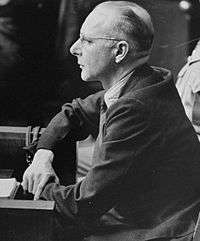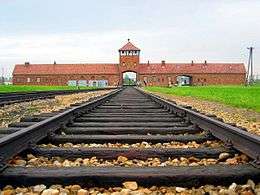Viktor Brack
| Victor Brack | |
|---|---|
|
Brack's photograph for the Nuremberg trial | |
| Born |
Viktor Hermann Brack 9 November 1904 Haaren, Rhine Province, German Empire |
| Died |
2 June 1948 (aged 43) Landsberg Prison, Landsberg am Lech, German Reich |
| Cause of death | Execution |
| Occupation | Chief of Office II: Affairs of the Party, State, and the Armed Forces in the Chancellery of the Führer of the NSDAP |
| Criminal penalty | Death by hanging |
| Motive | Nazism |
| Conviction(s) | Crimes against humanity |
Viktor Hermann Brack (9 November 1904 – 2 June 1948) was a German Nazi war criminal, the organiser of the Euthanasia Programme, Action T4, where the Nazi state systematically murdered over 70,000 disabled German and Austrian people. Following this, Brack was one of the men responsible for the gassing of Jews in the extermination camps, and he conferred with Odilo Globocnik about the practical implementation of the Final Solution. Brack was sentenced to death in 1947 and executed in 1948.
From a middle-class family, he became a member of the NSDAP and SS from the age of 25, and held increasing positions of responsibility in Hitler's Chancellery in Berlin. He was a senior colonel in the SS by the age of 35.
Career
Brack was born to a middle-class family in Haaren (now part of Aachen) in the Rhine Province. He was educated in local schools.
In 1929 at the age of 25, Brack became a member of the NSDAP and the SS. By 1936, he was appointed chief of Office 2 (Amt II) in the Chancellery of the Führer in Berlin. The office handled matters concerning the Reich Ministries, armed forces, Nazi Party, clemency petitions and complaints received by the Führer from all parts of Germany. On 9 November 1940, Brack was promoted to the grade of SS-Oberführer (senior colonel).
Action T4
In December 1939, Brack gave August Becker the task of arranging gas-killing operations of mentally ill patients and other people whom the Nazis deemed "life unworthy of life", which became known as Action T4. The program was related to popular early 20th-century ideas of eugenics and improving the race, not allowing disabled or mentally ill people to reproduce. Initially the doctors in the program sterilized people, then murdered nearly 15,000 German citizens at Hadamar Euthanasia Centre under an extension of this program.[1]
Following the war, during the 1947 Doctors' Trial in Nuremberg, Brack testified from the witness stand that after 1941, when the extermination of Jewish population by Nazis was at full capacity, Heinrich Himmler ordered him to contact physicians from the Euthanasia Program to find a way to sterilize young, strong Jews capable of labour for use in the German war effort. The goal was to develop a method by which the victim could be sterilized without being aware of the process. In March 1941, Brack fulfilled his assignment and prepared a report for Heinrich Himmler. He described the method of sterilizing patients using X-rays, without the victim's knowledge until the effects became obvious.
On 23 June 1942 Brack wrote the following letter to Himmler:

Dear Reichsführer, among tens of millions of Jews in Europe, there are, I figure, at least two to three millions of men and women who are fit enough to work. Considering the extraordinary difficulties the labour problem presents us with, I hold the view that those two to three millions should be specially selected and preserved. This can, however, only be done if at the same time they are rendered incapable to propagate. About a year ago I reported to you that agents of mine had completed the experiments necessary for this purpose. I would like to recall these facts once more. Sterilization, as normally performed on persons with hereditary diseases, is here out of the question, because it takes too long and is too expensive. Castration by X-ray however is not only relatively cheap, but can also be performed on many thousands in the shortest time. I think that at this time it is already irrelevant whether the people in question become aware of having been castrated after some weeks or months, once they feel the effects. Should you, Reichsführer, decide to choose this way in the interest of the preservation of labor, then Reichsleiter Bouhler would be prepared to place all physicians and other personnel needed for this work at your disposal. Likewise he requested me to inform you that then I would have to order the apparatus so urgently needed with the greatest speed.
- Heil Hitler! Yours
- VIKTOR BRACK.
Following the letter, Himmler ordered the procedure to be tested on prisoners in Auschwitz. Since Brack was transferred to an SS division, his deputy Blankenburg took over responsibility for the task and would "immediately take the necessary measures and get in touch with the chiefs of the main offices of the concentration camps".
Trial

A Jewish-French physician, a prisoner in Auschwitz from September 1943 to January 1945, testified in the "Doctors' Trial", part of the Nuremberg trials, that sterilization of Jewish inmates was carried out in Birkenau camp by SS doctors. He cared for nearly 100 male Poles who had been sterilized at Birkenau by surgical operations. According to the witness, members of the group were later castrated by camp physicians.
In later evidence, there was testimony that patients of other persecuted groups were sterilized under very high doses of X-rays for several minutes; this procedure was conducted on other persecuted groups. The men were later castrated.
During the Doctors' trial, Brack was convicted of murder of victims in the Euthanasia Program. The program was later applied under secret order "Action 14f13"; the extermination of those concentration camp inmates deemed unable to work. In March 1947, Bouhler's personal adjutant Karl Freiherr Michel von Tüßling provided an affidavit in defence of Victor Brack who was executed by hanging at Landsberg Prison, on 2 June 1948.
| Wikiquote has quotations related to: Viktor Brack |
Nazi Party decorations
- Golden Party Badge
- Nazi Party Long Service Award in Bronze and Silver
- SS Honor Ring
Notes
- ↑ Vernehmungsprotokoll der Sonderkommission des Hessischen Landeskriminalamtes Wiesbaden, V/1, April 4, 1960, see "Tötung in einer Minute". „Mitschrift der Vernehmung und Fahndungsschreiben von Dr. phil. August Becker“ (German)
